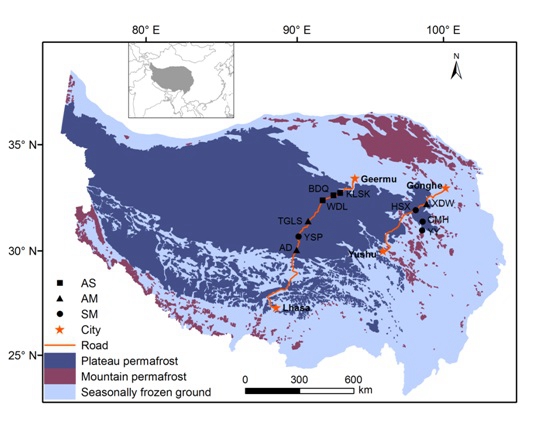Soil microorganisms play important roles in permafrost carbon cycling. Vast quantities of soil organic carbon could be decomposed by soil microorganisms, and thus result in significant fluctuations in atmospheric carbon dioxide (CO2) concentrations, intensifying global warming. However, our knowledge of patterns and drivers of permafrost microbial communities is limited over broad geographic scales.
Researchers from Institute of Botany of the Chinese Academy of Sciences examined soil bacterial, archaeal and fungal communities in the active and permafrost layers at ten sites on the Tibetan Plateau using high-throughput Illumina sequencing.
The research indicated that microbial alpha diversity was significantly higher in the active layer than in the permafrost layer, except the fungal Shannon–Wiener index and Simpson’s diversity index. Meanwhile, the microbial community structures were significantly different between the two layers.
They also revealed that environmental factors such as soil fertility were the primary drivers of the beta diversity of bacterial, archaeal and fungal communities in the active layer. In contrast, environmental variables such as the mean annual precipitation and total phosphorus played dominant roles in driving the microbial beta diversity in the permafrost layer. Spatial distance was important for predicting the bacterial and archaeal beta diversity in both the active and permafrost layers, but not for fungal communities.
Collectively, the research demonstrated different driving factors of microbial beta diversity between the active layer and permafrost layer, implying that the drivers of the microbial beta diversity observed in the active layer cannot be used to predict the biogeographic patterns of the microbial beta diversity in the permafrost layer.
This finding has been published in Molecular Ecology entitled “Distinct microbial communities in the active and permafrost layers on the Tibetan Plateau”. This work was supported by the National Key Research and Development Program of China, National Natural Science Foundation of China, Key Research Program of Frontier Sciences, Chinese Academy of Sciences, Chinese Academy of Sciences-Peking University Pioneer Cooperation Team.
Map of the sampling sites along two transects on the Tibetan Plateau (Image by Chen Yongliang)
Article links: http://onlinelibrary.wiley.com/doi/10.1111/mec.14396/full
Contact:
Prof. YANG Yuanhe
State Key Laboratory of Vegetation and Environmental Change
Institute of Botany, Chinese Academy of Sciences,
20 Nanxincun, Xiangshan, Beijing 100093, China
E-mail: yhyang@ibcas.ac.cn
Soil microorganisms play important roles in permafrost carbon cycling. Vast quantities of soil organic carbon could be decomposed by soil microorganisms, and thus result in significant fluctuations in atmospheric carbon dioxide (CO2) concentrations, intensifying global warming. However, our knowledge of patterns and drivers of permafrost microbial communities is limited over broad geographic scales.
Researchers from Institute of Botany of the Chinese Academy of Sciences examined soil bacterial, archaeal and fungal communities in the active and permafrost layers at ten sites on the Tibetan Plateau using high-throughput Illumina sequencing.
The research indicated that microbial alpha diversity was significantly higher in the active layer than in the permafrost layer, except the fungal Shannon–Wiener index and Simpson’s diversity index. Meanwhile, the microbial community structures were significantly different between the two layers.
They also revealed that environmental factors such as soil fertility were the primary drivers of the beta diversity of bacterial, archaeal and fungal communities in the active layer. In contrast, environmental variables such as the mean annual precipitation and total phosphorus played dominant roles in driving the microbial beta diversity in the permafrost layer. Spatial distance was important for predicting the bacterial and archaeal beta diversity in both the active and permafrost layers, but not for fungal communities.
Collectively, the research demonstrated different driving factors of microbial beta diversity between the active layer and permafrost layer, implying that the drivers of the microbial beta diversity observed in the active layer cannot be used to predict the biogeographic patterns of the microbial beta diversity in the permafrost layer.
This finding has been published in Molecular Ecology entitled “Distinct microbial communities in the active and permafrost layers on the Tibetan Plateau”. This work was supported by the National Key Research and Development Program of China, National Natural Science Foundation of China, Key Research Program of Frontier Sciences, Chinese Academy of Sciences, Chinese Academy of Sciences-Peking University Pioneer Cooperation Team.
Map of the sampling sites along two transects on the Tibetan Plateau (Image by Chen Yongliang)
Article links: http://onlinelibrary.wiley.com/doi/10.1111/mec.14396/full
Contact:
Prof. YANG Yuanhe
State Key Laboratory of Vegetation and Environmental Change
Institute of Botany, Chinese Academy of Sciences,
20 Nanxincun, Xiangshan, Beijing 100093, China
E-mail: yhyang@ibcas.ac.cn

